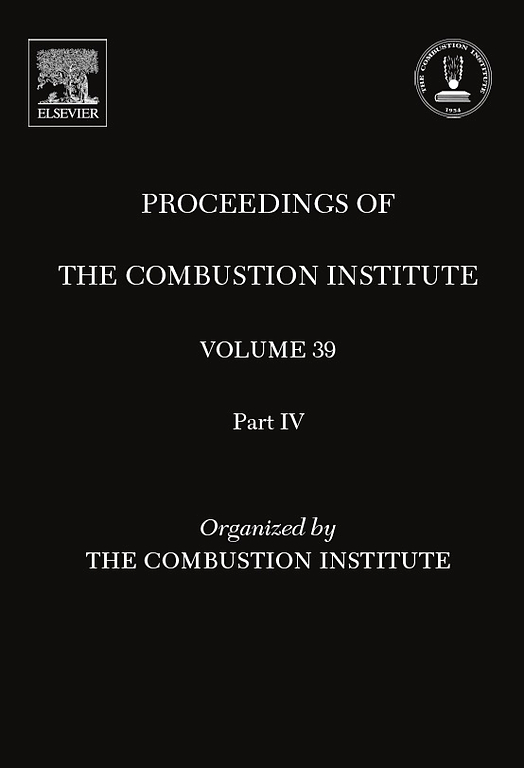池火中燃料蒸汽和火焰辐射阻滞的实验研究
IF 5.2
2区 工程技术
Q2 ENERGY & FUELS
引用次数: 0
摘要
水池火灾是加工工业中最常见的事故。揭示水池火灾的物理机理对于工艺安全和风险分析具有基础和实际应用价值。本文旨在研究燃料蒸汽和火焰在池火中引起的辐射阻塞现象。为了区分燃料蒸汽和火焰的辐射阻滞,本文进行了不同外部辐射热流量下的燃烧和蒸发(非燃烧)实验。实验中使用了四种不同的发烟燃料,包括甲醇、乙醇、正庚烷和甲苯。通过蒸发实验确定了燃料蒸气的辐射阻抗。通过燃烧实验研究了火焰的辐射阻滞和池火的总辐射阻滞。根据火焰辐射和外部辐射的辐射灰度假设,确定了有效辐射阻滞。结果发现,燃料蒸汽的有效辐射阻滞系数首先随燃料质量通量的增加而增加,然后逐渐接近一个恒定值,这是因为燃料蒸汽的辐射吸收能力随燃料质量通量的增加而趋于饱和。基于理论分析和实验数据,建立了燃料蒸汽辐射阻塞系数与燃料质量通量之间的相关关系。此外,甲醇、乙醇和正庚烷的火焰阻塞系数会随着外部辐射的增加而降低,这是因为火焰会膨胀,导致火焰的辐射热反馈增强。对于烟尘严重的燃料甲苯,由于烟尘浓度高,火焰辐射阻塞系数几乎与外部辐射保持一致。本文章由计算机程序翻译,如有差异,请以英文原文为准。
Experimental research on radiation blockage of the fuel vapor and flame in pool fires
Pool fires are the most prevalent accidents in the process industry. Revealing the physical mechanism of pool fire has both fundamental and practical applications in process safety and risk analysis. This paper intends to study the radiation blockage phenomenon caused by fuel vapor and flame in pool fires. Combustion and evaporation (non-combustion) experiments under different external radiative heat fluxes have been conducted to differentiate the radiation blockage of the fuel vapor and the flame. Four different sooting fuels including methanol, ethanol, n-heptane and toluene were used in the experiments. The radiation blockage of fuel vapor was determined through evaporation experiments. The radiation blockage of flame and the total radiation blockage of pool fires were investigated by burning experiments. Based on the assumptions of radiation gray for flame radiation and external radiation, the effective radiation blockage was determined. It is found that the effective radiation blockage coefficient of the fuel vapor increases with fuel mass flux first, and then gradually approaches a constant value because the radiation absorption capacity of the fuel vapor tends to saturate with the increase of fuel mass flux. The correlations between the fuel vapor radiation blockage coefficient and fuel mass flux are established based on theoretical analysis and experimental data. Moreover, the flame blockage coefficient decreases with external radiation for methanol, ethanol and n-heptane because the fire expands, causing enhanced radiative heat feedback from the flame. For the heavily sooting fuel, toluene, the flame radiation blockage almost remains constant with external radiation due to high soot concentrations.
求助全文
通过发布文献求助,成功后即可免费获取论文全文。
去求助
来源期刊

Proceedings of the Combustion Institute
工程技术-工程:化工
CiteScore
7.00
自引率
0.00%
发文量
420
审稿时长
3.0 months
期刊介绍:
The Proceedings of the Combustion Institute contains forefront contributions in fundamentals and applications of combustion science. For more than 50 years, the Combustion Institute has served as the peak international society for dissemination of scientific and technical research in the combustion field. In addition to author submissions, the Proceedings of the Combustion Institute includes the Institute''s prestigious invited strategic and topical reviews that represent indispensable resources for emergent research in the field. All papers are subjected to rigorous peer review.
Research papers and invited topical reviews; Reaction Kinetics; Soot, PAH, and other large molecules; Diagnostics; Laminar Flames; Turbulent Flames; Heterogeneous Combustion; Spray and Droplet Combustion; Detonations, Explosions & Supersonic Combustion; Fire Research; Stationary Combustion Systems; IC Engine and Gas Turbine Combustion; New Technology Concepts
The electronic version of Proceedings of the Combustion Institute contains supplemental material such as reaction mechanisms, illustrating movies, and other data.
 求助内容:
求助内容: 应助结果提醒方式:
应助结果提醒方式:


